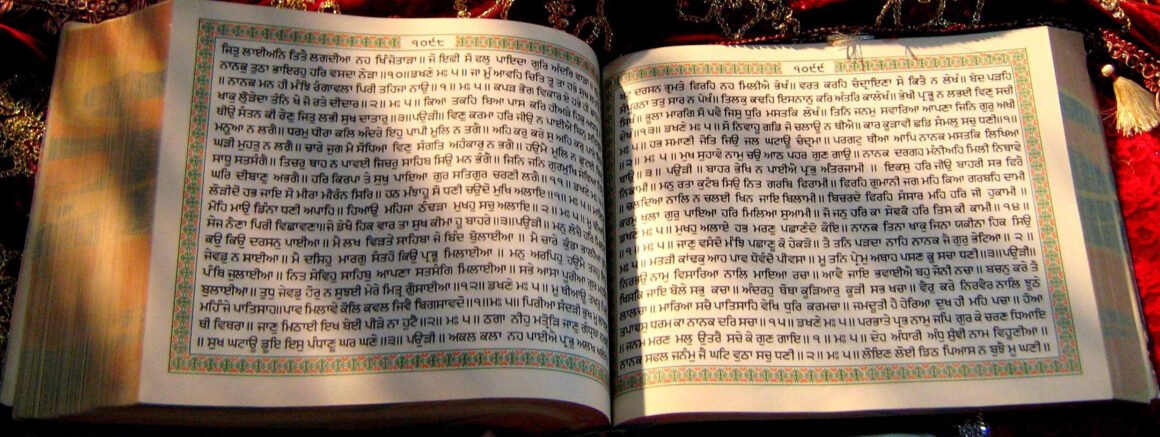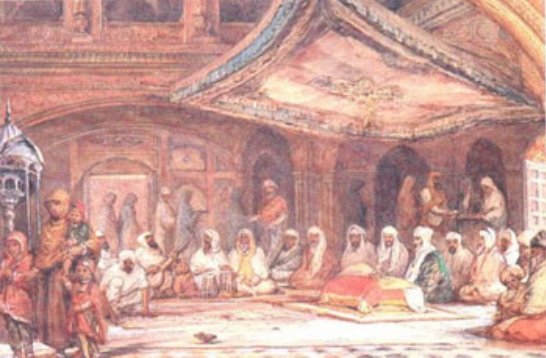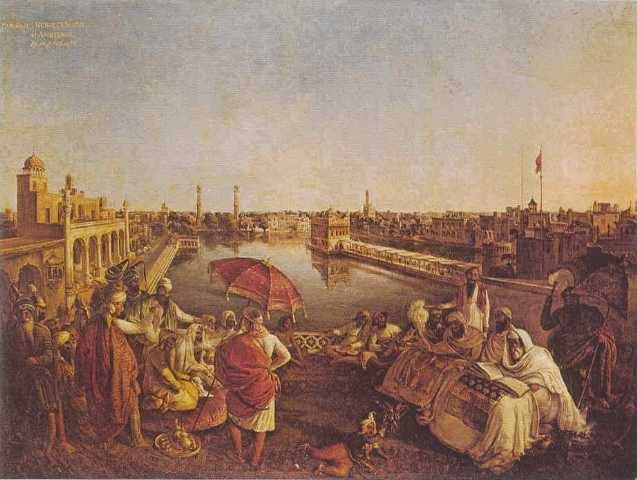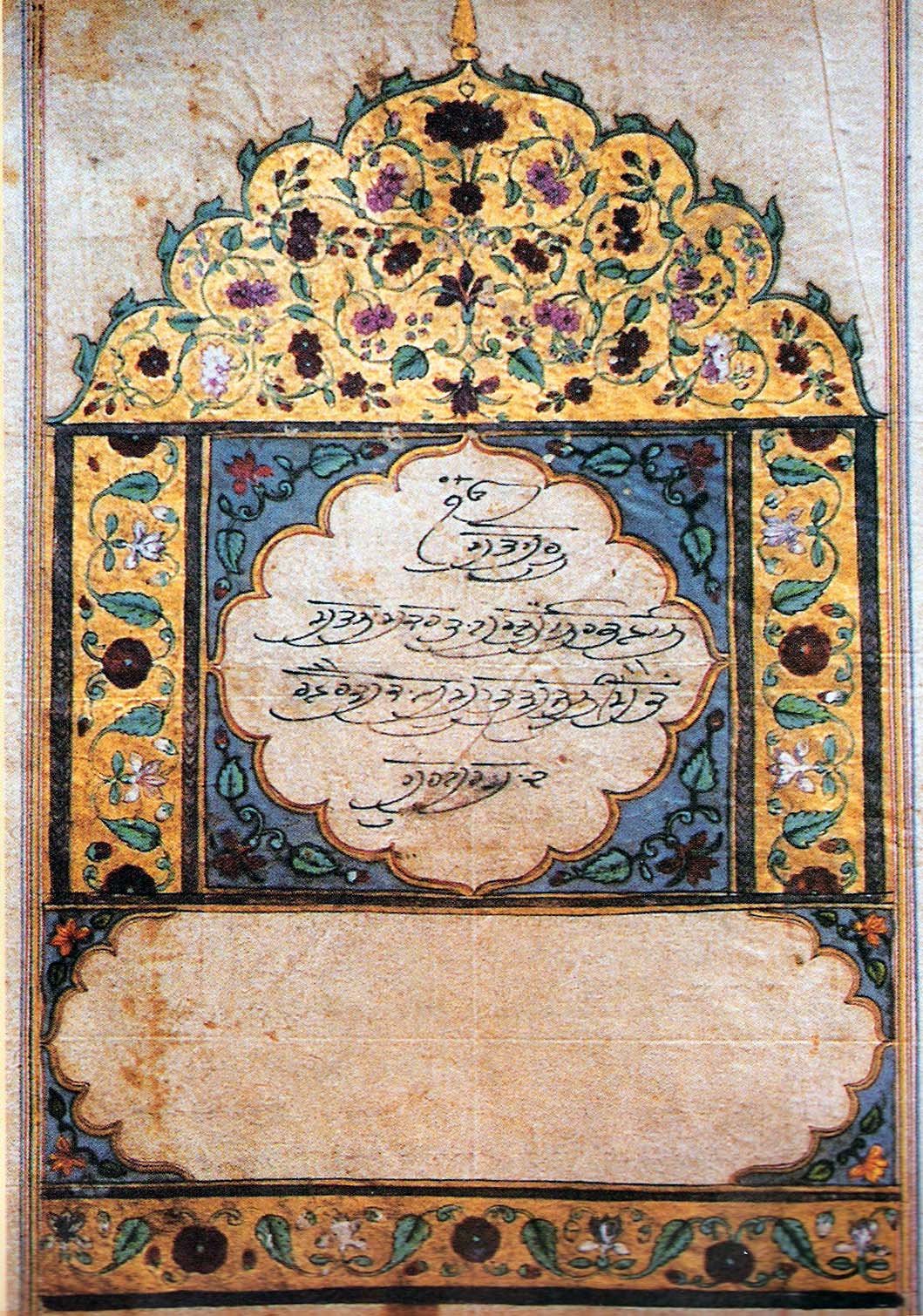Sab Sikhan ko hukam hai guru manyo granth
(Every Sikh, this is His will, accept Guru Granth as your only Guru – Guru Gobind Singh)

“Baanee Guru Guru hai baanee Vich baanee Amrit saare Gurbani kahai sewak jan maanai Partakh Guru nistaare” (982)
(Guru’s holy word is the true Guru and the Guru is the embodiment of the holy word. In the holy word is contained the nectar. If the attendant puts faith in what the Guru says then manifestly the Guru saves him)
| Sbestowed the status of Guru by Guru Gobind Singh in the ri Guru Granth Sahib, the holy Sikh Scripture, was year 1708, at Takht Sachkhand Hazur Sahib, at Nanded in Maharashtra. This holy book was first compiled and edited by Guru Arjan Dev, the fifth Guru, in 1604. Guru Granth Sahib is distinct and unique, as it contains the spiritual hymns and verses not only of the Sikh Gurus, but also of enlightened persons of other castes and religions, including the Mohammedans. The Sikhs regard the Holy Granth as a living Guru and bow before it to seek guidance for their problems – both spiritual and temporal. |

| The holy hymns are believed to be God’s own commands conveyed by His own order through the Sikh Gurus and various spiritualists, who were dedicated to the only ‘One’ unfathomable Lord. With unflinching faith, they meditate on His name at every breath, maintaining their sublimity and service for all. They refrain from any sort of idol worship and rituals. The task of collecting these scriptures, particularly of the Bhagats was extremely difficult, because the basic principle of worship of only one God was like the touch-stone test. This task was commenced by Guru Nanak, who strictly maintained the principles of “Fatherhood of God and universal brotherhood of mankind.” His preaching was so frank and simple that he was welcomed and carefully listened to, wherever he went during his four hazardous travels called Udasis. His verses had a magical effect, which he would sing to the strings of Rabab (the rebeck) of Mardana. Guru Nanak would write in a note book (referred to as the pothi by the historians), each and every verse, which he recited: Hao aappah bol na jaandaa, Mai kahiaa sabh hukmaa-o jeeo (763) (I myself do not know how to speak, whatever I have uttered is as the Lord has ordained) |

| Back to his village Kartarpur, after his Udasis (travels), he returned to plough his fields and also preached at mornings and evenings in a small prayer hall. Bhai Lehna succeeded him as Guru Angad, whom, before merging with the Divine Light, Guru Nanak handed over his book of spiritual verses. Guru Angad also wrote the holy hymns, which were similarly, passed on to his successor, the third Guru Amar Das. Undoubtedly, Guru Nanak’s holy spirit, which prevailed in the second Guru, shone in the third Guru as well. The third Guru in turn, composed quite a number of spiritual hymns regularly, at his Goindwal congregation center and arranged for the recording of the same with due care. The next successor, Ram Das, whose ‘selfless service’ had pleased Guru Amar Das, was sent by the third Master, to set up a new congregational center with a bathing tank (Sarovar), some 30 miles North of Goindwal on the land, which Emperor Akbar had given to Bibi Bhani, daughter of Guru Amar Das and the wife of Ram Das. Initially the place was called Guru Ka Chak or Ramdaspur and later named Amritsar. A prayer hall was soon ready while the work on the Sarovar was on and Guru Amar Das visited to oversee the progress occasionally. It was here, that Bhai Jetha was installed as the fourth Guru Ramdas. Earlier, in Goindwal, Guru Amar Das had handed over to his trustworthy son, Mohan Ji, all the holy scriptures collected thus far (Properly arranged under his own supervision, in small volumes called pothies). Besides the writings of the three Gurus, this collection also contained the verses by 19 saints and sages including Kabir, Farid, Ravidas, Namdev etc., collected by the Gurus. |

| Along with the construction of the Sarovar at Amritsar, Guru Ram Das preached in the mornings and evenings, to the Sangat, in the make shift temple. His own holy verses, which he used to sing were being recorded and safeguarded by his son, Arjan Dev, who succeeded him as the fifth Guru. Guru Arjan, while still a little boy, was blessed by Guru Amar Das thus: Dohita Baani Ka Bohitha (Grandson, the Gurbani yacht) |
Guru Arjan was a born poet, a talented musician and had knowledge of most of the contemporary languages. His sweetly composed numbers were reverently sung by the Sikhs. Soon after, he took up the task of compiling the holy scriptures of the Pothies into one voluminous book (the Adi Granth), for which task he had to personally go to Goindwal, where with all the reverence, he approached Baba Mohan Ji and obtained the valued scriptural treasure, which Baba Ji would not trust to hand over to anyone else.
Back in Amritsar Guru Arjan Dev camped at Gurdwara Ramsar. After adding the Gurbani of the fourth Guru and his own, he summoned Bhai Gurdas, a devout Sikh and a noted scholar, who was highly conversant in Sanskrit and other Indian languages, to write on his dictation, the great treasure of the pothies in a very systematic order. Lots of holy persons, spiritual scholars and the popularly known 12 Bhatts (the bards), whose verses were also included by the Guru, became regular visitors of Amritsar.
Guru Arjan Dev started this noble project in 1601 and having completed the same in 1604, the Adi Granth was brought with respectfully to the newly built beautiful hall of Harmandir. Baba Buddha, one of the most respected Sikhs of Guru Nanak’s times was appointed as the first Granthi (Priest) to read out the spiritual command (Hukamnama). The Guru himself attributed so much respect to the Granth Sahib that he never sat or slept at a place higher than its seat (Sukh Aasan). The Sikhs followed the suit with great reverence.
All the Gurbani compositions are in perfect poetic numbers and musical melodies (Raagas) in Guru Granth Sahib. They were and are still sung by the learned singers, at the particular timings, seasons and occasions in the Gurdwaras as well as other religious congregations. Spiritually blissful, they are capable of creating state of ecstasy. There are lessons also for living in a harmonious environment with others. There are no trifle stories or fairy tales or fanatic regulations of rituals etc. in its 1430 pages.
The Adi Granth was recompiled by Guru Gobind Singh in 1704 at Sabo-ki-Talwandi (Damdama Sahib) in order to incorporate the verses composed by the ninth Guru, Teg Bahadur, which he did so efficiently that the order set by the fifth Master was not disturbed. Before he merged with the Divine Light, on 3 October, 1708, Guru Gobind Singh bestowed the Guruship to the final volume and emphatically ordained:
Guru Granth Ji Maneyo Pragat Guran Ki Deh
(Reckon Guru Granth Sahib as the visible living incarnation of the Gurus).

Obeying this command, the Sikhs consider any controversy on this order, as sacrilege. There is no way anyone would make any addition or subtraction what so ever.
The General Set up
1. There is a data index to guide the reader through the page of all the contents, indicating the raagas and the initial verse of each raaga.

| At the end, after Shaloka Mehla 9 is Guru Arjan’s concluding hymns, Mundhaavani Mehla 5 (Mundana or Mudran means ‘closing hymn’): Thaal vich tin-n wastoo pa-ee-o satt santokh veechaaro (1429) (In the salver are lying three things; truth, contentment and contemplation) and Tera keeta jaato naahi (1429) (I cannot at all realize, what you have done for me, O Lord.) Guru Granth Sahib is authentic in all respects: Guru Arjan’s strict system of compilation is highly infringing proof. Each composition of every author is carefully numbered for its verses and topic and each set of every chapter is also reckoned, for the total hymns and for the topic etc.Thus there is no way by which one can add, take-away or disturb the set up of compositions. For this reason, the scriptures of Guru Granth Sahib stay unique, authentic and preserved, beyond any doubt. Guru Ram Dass, the fourth Guru proclaimed: |

| Baanee guru guru hai baanee vich baani amrit saare, Gurbaanee kahai sewak jan maanai partakh guru nistaare (982) (Guru’s holy word is the true Guru and the Guru is the embodiment of the holy word. In the holy word is contained the nectar. If the attendant puts faith in what the Guru says then manifestly the Guru saves him.) What Guru Ram Das said, proved true and the tenth Guru gave the verdict to the Sikhs at the time of his merging with the Divine Light that Guru Granth Sahib will henceforth be the Guru of the Sikhs and all the Sikhs will bow before Guru Granth Sahib and not before any living Guru. The teachings included in this Granth explain that monotheism does not mean defecation of God, which leads individual to resort to idol worship or such other practices with a view to attaining his favor in a manner that would mean the negation of the established order of the universe, which in the word of Guru Angad is the dwelling place of Almighty Himself. So this way the unity of God implied the sanctification of all relative existence. This is how the teachings enshrined in Guru Granth Sahib reject ascetism, celibacy, austerities, ritualism and formalism in totality. Thus Guru Granth Sahib includes the contributions from Gurus, Saints and Bhagats of various religions which evolve the spirit of secularism in the society. |








